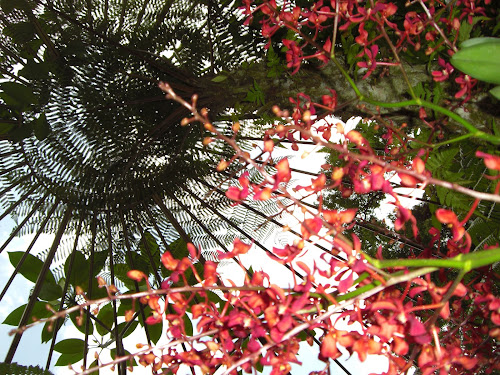Wow, what an experience our four days on horseback through a VERY rural and hilly Rajasthan has been. We've felt like a cross between Brangelina, as we passed through village after village smiling and waving so much at calling children and shy adults that it's given us repetitive strain injuries, and circus freaks, as people have gathered around us staring intently and without embarrassment whilst we tried to eat breakfast, brush our teeth or simply read a book.
We must first thank Nancy, who gave us the skills and confidence to tackle "walk", "trot" and "canter" before we left England - unfortunately she couldn't help us to pre-empt extremely spirited horses and lots of hill walking, rock climbing and river wading. The Marwari horses we have been riding are slender, sensitive and have distinctive curly ears. They were used for war and hunting by the Maharajahs for hundreds of years.
 |
| Feisty Namari |
The trek has also brought us several other "firsts", one being the outdoor toilet facilities for ones and twos (namely a rustic commode over a pit or behind a wall or bush), another being the lack of showering facilities for four days so it's been a top and tail with a wet flannel or hair washing with a bucket full of river water. We've had meals round a camp fire each night and there's been all kinds of new wildlife to spot (electric blue kingfishers, mongoose, yellow woodpeckers etc).
 |
| Washing my hair |
The scenery has been mountainous and dry with the occasional lake and lush crop areas. Terrain has been a combination of steep rocky pathways, concrete roads and river crossings as we climbed higher and higher heading for Kumbalgarh Fort. Village life and it's simplicity has astounded us as the majority of dwellings have no electricity or running water (a village pump provides this). A mixture of cow, buffalo and goats are kept in pens around the housetops provide milk and the dung is patted and sun dried to use as fuel for the fires. Camel, cow and buffalo are the work force here, carrying heavy goods and pushing the water mill around to draw water from the wells to the crops. Mustard seed, sugar cane, tomatoes and wheat have been the most prominent crops.
 |
| Horns painted for Diwali |
 |
| Making it look no effort |
 |
| Brick making by hand |
Shocking too is how basic their existence is....children play with hoop and stick and a simple marble flicking game or just sit about. Shoes are not worn and bathing and brushing teeth seem to be unimportant.... it makes the bright white smiles and gorgeous vibrant saris look out of place amidst the dust, dirt and animals. Ladies can be seen carrying anything from huge pots of water, 12ft lengths of cane or large bundles of leaves on their heads.
Schools have been intriguing too - the state uniform of baby blue shirt and tan trousers look smart but it appears you can rock up at school whatever time you feel like, lessons a held outside, on the ground en masse and the cane/slap around the head is very much still acceptable.
Each day we have ridden for about 5 hours, starting the day with an outdoor breakfast and stopping half way for lunch. Late afternoon we have stopped at a new camp, set up by the guys before we arrive. An hour or two until darkness when a camp fire is lit and dinner eaten. The best meals of all our Indian trip! Without electricity bedtime has been around 8.30pm but despite the early retirement, sleep has been challenging with unusual noises and freezing temperatures to disturb us. The guys who run the trek have all slept outside on the floor, making us feel guilty in our bedded tent.
 |
| Camp near the river |
 |
| Keeping warm by the camp fire |
On one of the evenings, we were treated to a trip on the back of the truck up to a remote Hindu temple in the forest. We drank tea with a Sadhu and then watched the evening Puja ceremony and with candles lit, bells rung and drums beaten, it was another interesting experience, topped off with Rob smoking some of the Sadhus home grown Ganga.
Our nemeses this adventure have been rock hard cavalry saddles and sore bottoms as well as roaming buffalo who terrorise the horses with their scatty, lollopping run and large horns but overall this has been an amazing four days and definitely worth the saddle sores.


















































